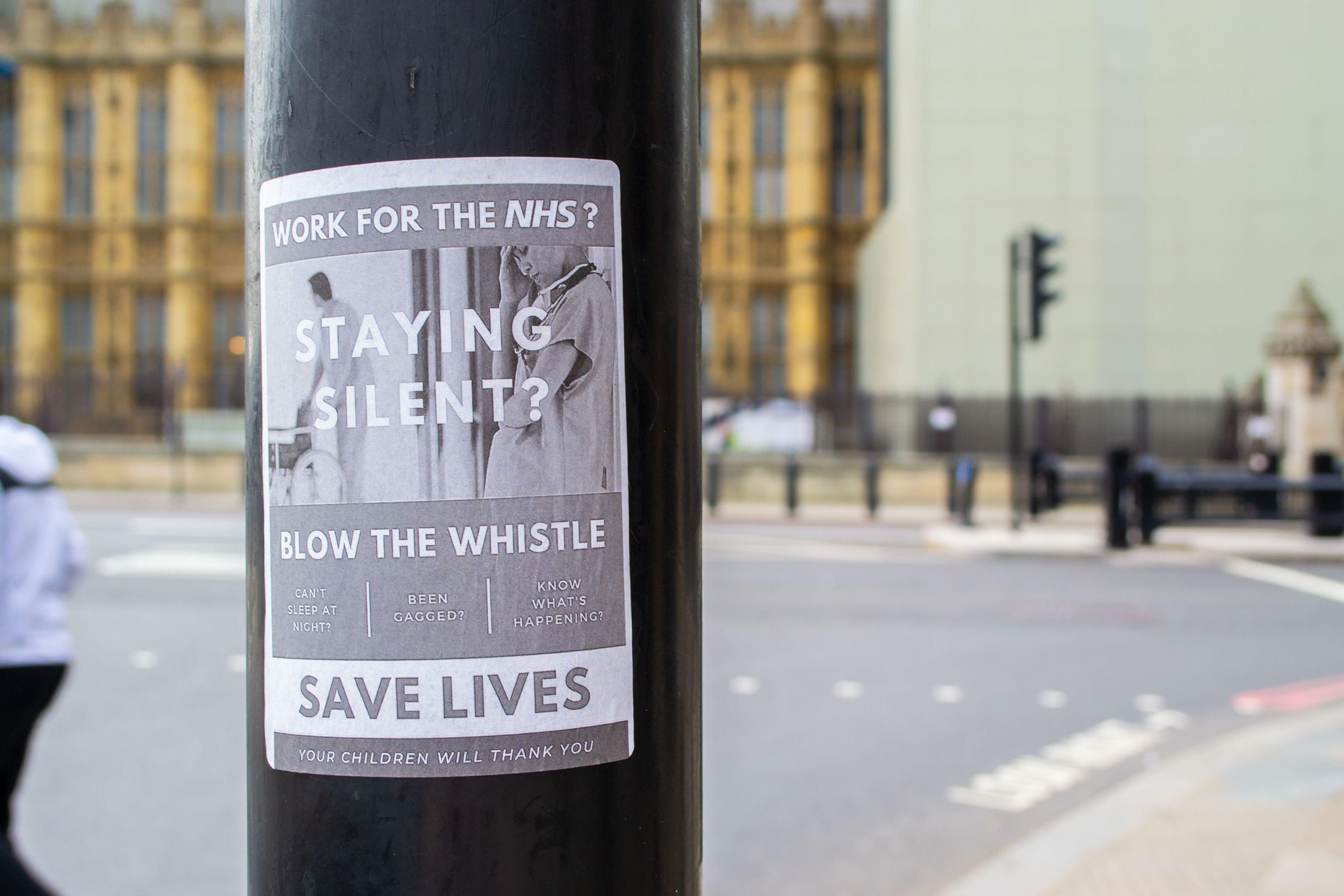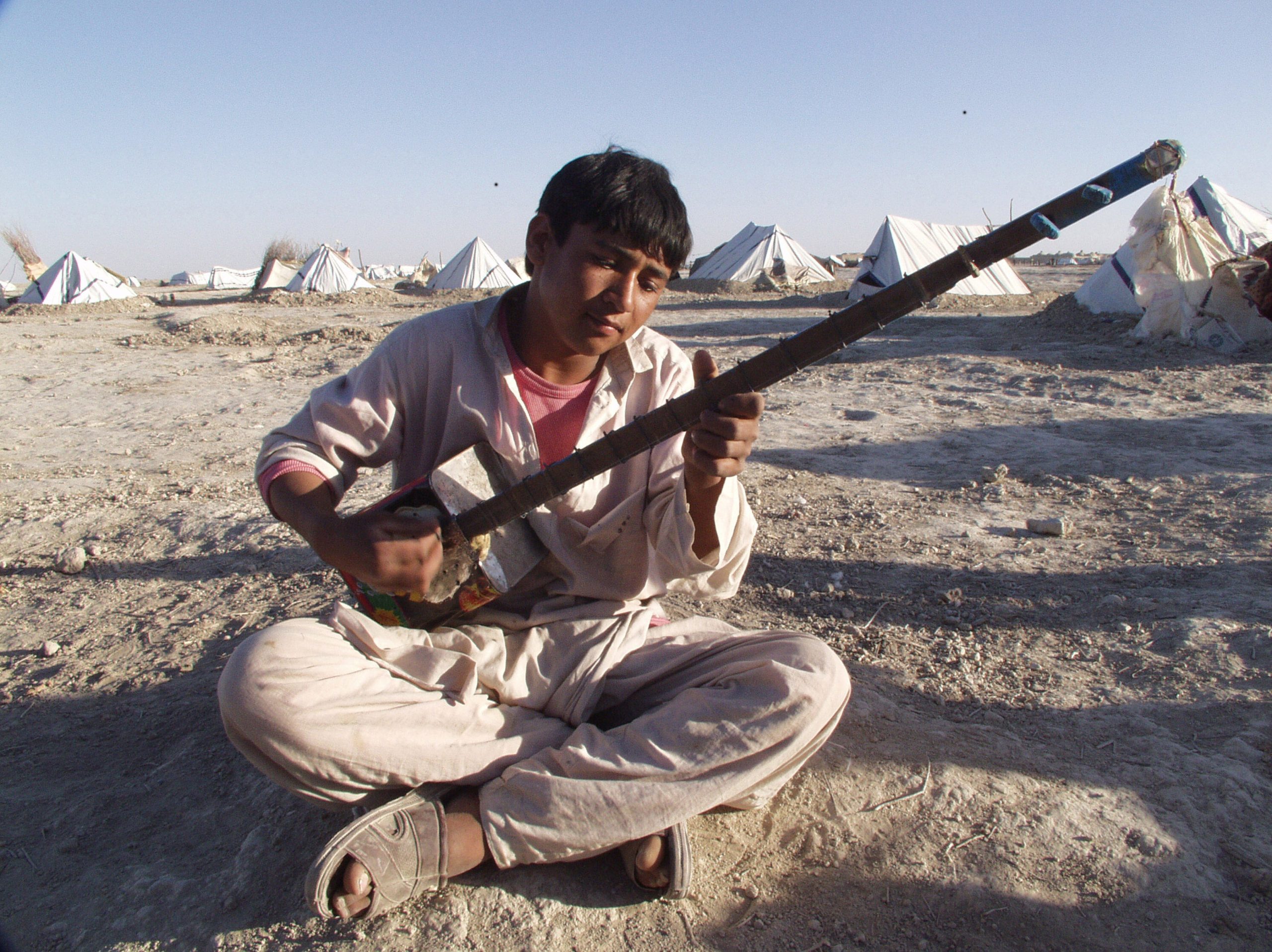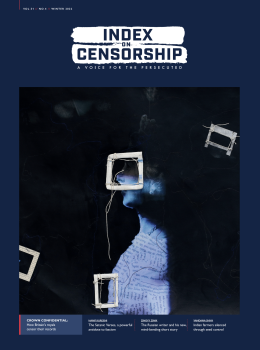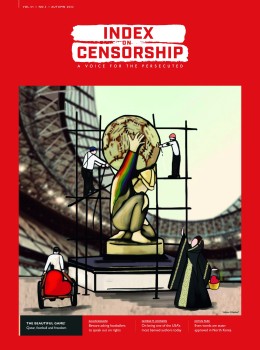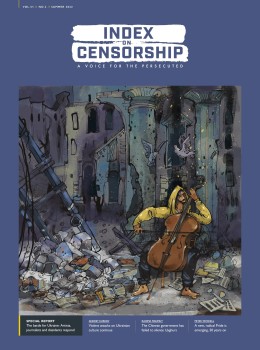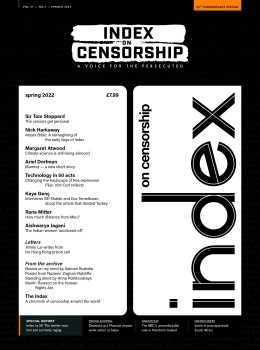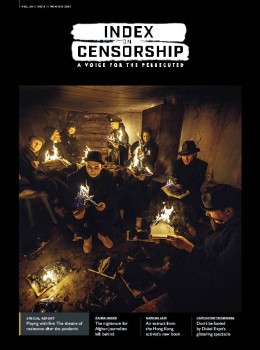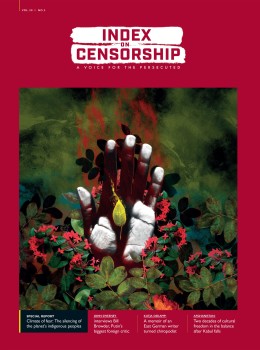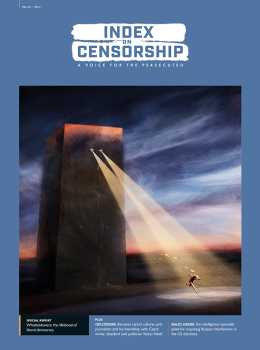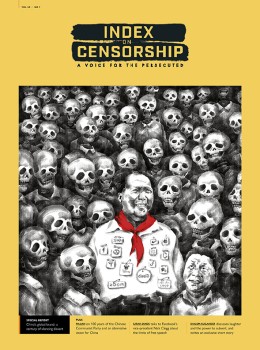[vc_row full_width=”stretch_row” full_height=”yes” css=”.vc_custom_1481647350516{background-image: url(https://www.indexoncensorship.org/wp-content/uploads/2016/12/magazine-cover-subhead.jpg?id=82616) !important;background-position: center !important;background-repeat: no-repeat !important;background-size: contain !important;}”][vc_column][/vc_column][/vc_row][vc_row][vc_column][vc_custom_heading text=”Governments that introduce bans on clothing and other forms of expression are sending a signal about their own lack of confidence” google_fonts=”font_family:Libre%20Baskerville%3Aregular%2Citalic%2C700|font_style:400%20italic%3A400%3Aitalic”][/vc_column][/vc_row][vc_row][vc_column][vc_column_text]
IF YOU HAVE to introduce laws telling your citizens that they are banned from wearing purple, sporting red velvet, or showing their knees, then, frankly, you are in trouble.
But again and again, when times get tough or leaders think they should be, governments tell their people what to wear, or more often, what not to wear.
“Dare to wear this,” they say, “and we will be down on you like a ton of bricks.” Why any government thinks this is going to improve their power, the economy or put their country on a better footing is a mystery. History suggests you never strike up a more profitable relationship with your people by removing the freedom to wear specific types of clothing or, conversely, telling everyone that they have to wear the same thing. We are either consumed by rebellion, or by dullness.
The Romans tried it with purple (only allowed for the emperor and his special friends). The Puritans tried it with gold and silver (just for the magistrates and a few highfaluting types). Right now the governments of Saudi Arabia and Iran ban women from wearing anything but head-to-toe cover-ups along with a range of other limitations. In one frightening case in the past month there were calls via social media for a woman in Saudi Arabia to be killed because she went out shopping “uncovered” without a hijab or abaya. One tweet read: “Kill her and throw her corpse to the dogs.”
Banning any type of freedom of expression, often including free speech, or freedom of assembly, usually happens in times of national angst, economic downturn or crisis, when governments are not acting either in the interest of their people, or the national good. These are not healthy, confident nations, but nations that fear allowing their people to speak, act and think. And that fear can express itself in mandating or restricting types of expression. Generally, as with other restrictions on freedom found in the US First Amendment, enforcing such bans doesn’t sweep in a period of prosperity for countries that impose them.
At different points in world history governments have forced a small group of people to wear particular things, or tried to wipe out styles of clothing they did not approve of. In medieval Europe, for instance, non-Christians were, at certain periods, forced to wear badges such as stars or crescents as were Christians who refused to conform to a state religion, such as the Cathars. Forcing a particular badge or clothing to be worn sends a signal of exclusion. Those authorities are, by implication, saying to the majority that there is a difference in the status of the minority, and in doing so opening them up either to attack, or at least suspicion. Not much has changed between then and now. Historically groups that have been forced to wear some kind of badge or special outfit have then found themselves ostracised or physically attacked. The most obvious modern example is Jews being forced to wear yellow stars in Nazi Germany, but this is not the only time minorities have been legally forced to stand out from the crowd. In 2001 the Taliban ruled that Afghan Hindus had to wear a public label to signify they were non-Muslims. The intent of such actions are clear: to create tension.
The other side of this clothing coin is when clans, tribes or groups who choose to dress differently from the mainstream, for historical religious reasons, or even just because they follow a particular musical style, are persecuted because of that visual difference, because of what it stands for, or because they are seen as rebelling against authority. In some cases strict laws have been put in place to try and force change, in other cases certain people decide to take action. In 1746, for instance, the British government banned kilts and tartans (except for the military) under the Dress Act, a reaction said to be motivated by support for rebellions to return Catholic (Stuart) monarchs to the British throne. Those who ignored the order faced six months in prison for the first instance, and seven years deportation for the second. Those who wear distinctive, and traditional clothing, out of choice can face other disadvantages. For years, the Oromo people in Ethiopia, who wear distinctive clothing, have long faced discrimination, but in 2016 dozens of Oromo people were killed at a religious festival, after police fired bullets into the crowd. And in her article Eliza Vitri Handayani reports on how the punk movement in Indonesia has attracted animosity and in one case, Indonesian police seized 64 punks, shaved their heads and forced them to bathe in a river to “purify themselves”. Recently the Demak branch of Nadhlatul Ulama, Indonesia’s largest Islamic organisation, has banned reggae and punk concerts because they make young people “dress weird”.
Another cover for restrictions or bans stems from religions. As soon as the word “modesty” is bandied around as a reason for somebody to be prohibited from wearing something then you know you have to worry. Strangely, it is never the person who proclaims that there needs to be a bit more modesty who needs to change their ways. Of course not. It is other people who need to get a lot more modest. The inclusion of modesty standards tends to be used to get women to cover up more than they have done.
[/vc_column_text][/vc_column][/vc_row][vc_row][vc_column width=”1/4″][vc_icon icon_fontawesome=”fa fa-quote-left” color=”custom” align=”right” custom_color=”#dd3333″][/vc_column][vc_column width=”3/4″][vc_custom_heading text=”When freedom of expression is quashed, it usually finds a way of squeezing out just to show that the spirit is not vanquished” google_fonts=”font_family:Libre%20Baskerville%3Aregular%2Citalic%2C700|font_style:400%20italic%3A400%3Aitalic”][/vc_column][/vc_row][vc_row][vc_column][vc_column_text]
Then you get officious types who decide that they have the measure of morality, and start hitting women wearing short skirts (as is happening right now in South Africa and Uganda). For some Ugandan women it feels like a return to the 1970s under dictator Idi Amin “morality” laws.
Trans people can find themselves confronting laws, sometimes centuries old, that lay out what people shouldn’t be allowed to wear. In Guyana a case continues to edge through the court of appeal this year, it argues that a cross-dressing law from 1893 allows the police to arrest or harass trans people. A new collection, the Museum of Transology, which opens in London in January, uses a crowdsourced collection of objects and clothing to chart modern trans life and its conflicts with the mainstream, from a first bra to binders.
When freedom of expression is quashed, it usually finds a way of squeezing out just to show that the spirit is not vanquished. So during the tartan ban in the 18th century, there are tales of highlanders hiding a piece of tartan under other clothes to have it blessed at a Sunday service. And certainly tartan and plaids are plentiful in Scotland today. In the 1930s and 40s when British women and girls were not “expected” to wear trousers or shorts, some bright spark designed a split skirt that could be worn for playing sport. It looked like a short dress (therefore conforming to the accepted code), but they were split like shorts allowing girls to run around with some freedom.
While in Iran, where rules about “modest” dress are enforced viciously with beatings, sales of glitzy high heels go through the roof. No one can stop those women showing the world their personal style in any way they can. Iranian model and designer Tala Raassi, who grew up in Iran, has written about how vital those signs of style are to Iranian women. In a recent article, commenting on the recent burkini ban in France, Raassi wrote of her disappointment that a democratic country would force an individual to put on or take of a piece of clothing. She added: “Freedom is not about the amount of clothing you put on or take off, but about having the choice to do so.”
And that freedom is the clearest sign of a healthy country. We must support the freedom for individuals to make choices, even if we do not agree with them personally. The freedom to be different, if one chooses to be, must not be punished by some kind of lower status or ostracism. National leaders have to learn that taking away freedom of expression from their people is a sign of their failure. Countries with the most freedom are the ones that will historically be seen as the most successful politically, economically and culturally.
[/vc_column_text][/vc_column][/vc_row][vc_row][vc_column][vc_column_text]
Rachael Jolley is the editor of Index on Censorship magazine. She recently won the editor of the year (special interest) at British Society of Magazine Editors’ 2016 awards
[/vc_column_text][/vc_column][/vc_row][vc_row][vc_column][vc_custom_heading text=”From the Archives”][vc_row_inner][vc_column_inner width=”1/3″][vc_single_image image=”86201″ img_size=”213×289″ alignment=”center” onclick=”custom_link” link=”http://journals.sagepub.com/doi/pdf/10.1177/0306422016643039″][vc_custom_heading text=”T-shirted turmoil” font_container=”tag:p|font_size:24|text_align:left” link=”url:http%3A%2F%2Fjournals.sagepub.com%2Fdoi%2Fpdf%2F10.1177%2F0306422016643039|||”][vc_column_text]April 2016
Vicky Baker looks at why slogan shirts are more than a fashion statement and sometimes provoke fear within great state machines.[/vc_column_text][/vc_column_inner][vc_column_inner width=”1/3″][vc_single_image image=”89180″ img_size=”213×289″ alignment=”center” onclick=”custom_link” link=”http://journals.sagepub.com/doi/pdf/10.1080/03064220600624127″][vc_custom_heading text=”Miniskirts” font_container=”tag:p|font_size:24|text_align:left” link=”url:http%3A%2F%2Fjournals.sagepub.com%2Fdoi%2Fpdf%2F10.1080%2F03064220600624127|||”][vc_column_text]February 2006
Salil Tripathi believes the press should not pick and choose what to publish based on who will get offended. [/vc_column_text][/vc_column_inner][vc_column_inner width=”1/3″][vc_single_image image=”90622″ img_size=”213×289″ alignment=”center” onclick=”custom_link” link=”http://journals.sagepub.com/doi/pdf/10.1080/03064228908536934″][vc_custom_heading text=”List to the right ” font_container=”tag:p|font_size:24|text_align:left” link=”url:http%3A%2F%2Fjournals.sagepub.com%2Fdoi%2Fpdf%2F10.1080%2F03064228908536934|||”][vc_column_text]July 2001
UK’s Terrorism Act 2000 is further evidence of the government’s indifference to fundamental freedoms – clothing included.[/vc_column_text][/vc_column_inner][/vc_row_inner][vc_separator][/vc_column][/vc_row][vc_row][vc_column width=”1/3″][vc_custom_heading text=”Fashion Rules” font_container=”tag:p|font_size:24|text_align:left” link=”url:https%3A%2F%2Fwww.indexoncensorship.org%2F2016%2F12%2Ffashion-rules%2F|||”][vc_column_text]The winter 2016 issue of Index on Censorship magazine looks at fashion and how people both express freedom through what they wear.
In the issue: interviews with Lily Cole, Paulo Scott and Daphne Selfe, articles by novelists Linda Grant and Maggie Alderson plus Eliza Vitri Handayani on why punks are persecuted in Indonesia.[/vc_column_text][/vc_column][vc_column width=”1/3″][vc_single_image image=”82377″ img_size=”medium” alignment=”center” onclick=”custom_link” link=”https://www.indexoncensorship.org/2016/12/fashion-rules/”][/vc_column][vc_column width=”1/3″][vc_custom_heading text=”Subscribe” font_container=”tag:p|font_size:24|text_align:left” link=”url:https%3A%2F%2Fwww.indexoncensorship.org%2Fsubscribe%2F|||”][vc_column_text]In print, online. In your mailbox, on your iPad.
Subscription options from £18 or just £1.49 in the App Store for a digital issue.
Every subscriber helps support Index on Censorship’s projects around the world.
![]() SUBSCRIBE NOW[/vc_column_text][/vc_column][/vc_row]
SUBSCRIBE NOW[/vc_column_text][/vc_column][/vc_row]

